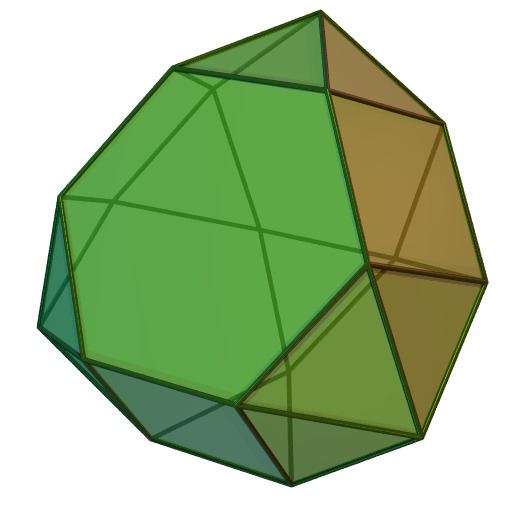Type JohnsonJ91 - J92 - J1 Vertices 18 | Edges 36 Symmetry group C3v | |
 | ||
Vertex configuration 3(3.5)6(3.4.3.5)3(3.5.3.5)2.3(3.4.6) | ||
In geometry, the triangular hebesphenorotunda is one of the Johnson solids (J92).
A Johnson solid is one of 92 strictly convex polyhedra that have regular faces but are not uniform (that is, they are not Platonic solids, Archimedean solids, prisms or antiprisms). They were named by Norman Johnson, who first listed these polyhedra in 1966.
It is one of the elementary Johnson solids, which do not arise from "cut and paste" manipulations of the Platonic and Archimedean solids. However, it does have a strong relationship to the icosidodecahedron, an Archimedean solid. Most evident is the cluster of three pentagons and four triangles on one side of the solid. If these faces are aligned with a congruent patch of faces on the icosidodecahedron, then the hexagonal face will lie in the plane midway between two opposing triangular faces of the icosidodecahedron.
The triangular hebesphenorotunda is the only Johnson solid with faces of 3, 4, 5 and 6 sides.
Coordinates
The coordinates of the triangular hebesphenorotunda are:
where
These coordinates produce a triangular hebesphenorotunda with edge length 2, resting on the XY plane and having its 3-fold axis of symmetry aligned to the Z-axis. A second, inverted, triangular hebesphenorotunda can be obtained by negating the second and third coordinates of each point. This second polyhedron will be joined to the first at their common hexagonal face, and the pair will inscribe an icosidodecahedron. If the hexagonal face is scaled by the Golden Ratio, then the convex hull of the result will be the entire icosidodecahedron.
